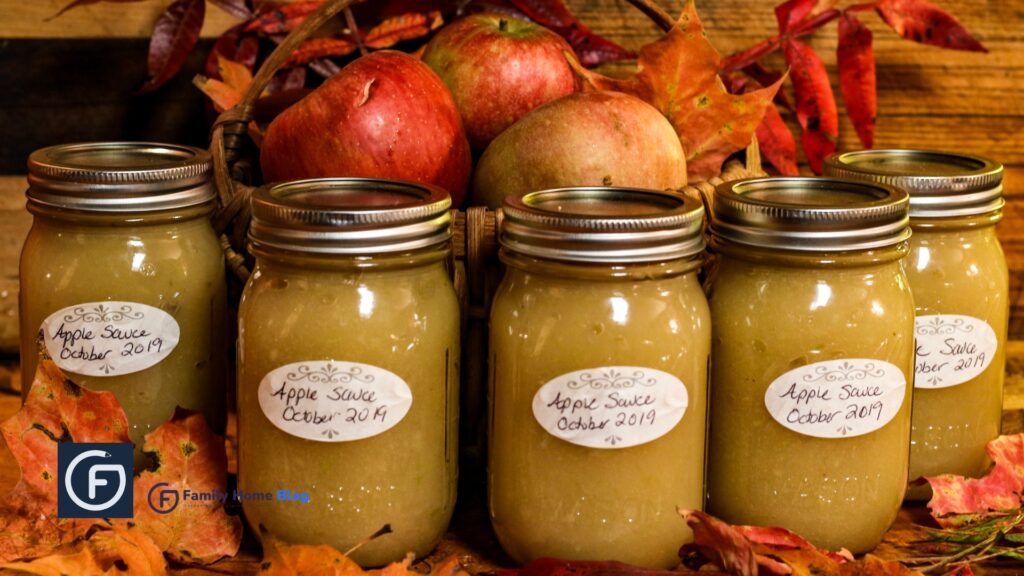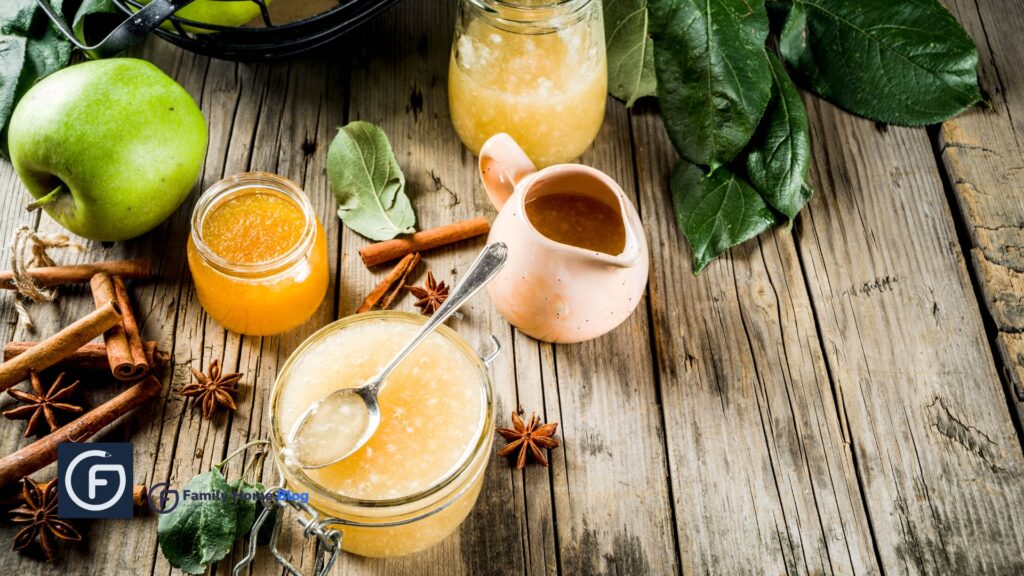Introduction
Welcome to our comprehensive guide on canning applesauce! Canning applesauce is a fantastic option if you have an abundance of apples and want to preserve their deliciousness for later use. Whether you’re a beginner or an experienced canner, this article will provide all the information you need to successfully can your flavorful applesauce.
Why Choose Canning Applesauce?

Canning applesauce offers numerous advantages. It allows you to preserve the flavors and nutrients of freshly harvested apples, ensuring you have a ready supply of this versatile and delicious treat throughout the year. Homemade applesauce also gives you control over the ingredients, allowing you to customize it to your taste preferences and dietary needs.
Preparing Apples for Canning

Before diving into the canning process, it’s essential to properly prepare your apples. Follow these simple steps:
- Selecting Apples: Choose ripe and flavorful apples. Varieties like Granny Smith, McIntosh, or Golden Delicious work well for applesauce due to their texture and taste.
- Washing and Peeling: Thoroughly wash the apples under running water to remove dirt or impurities. Peel the apples using a paring knife or a vegetable peeler.
- Coring and Chopping: Core the apples and remove the seeds. Chop them into small, uniform pieces for even cooking.
Equipment Needed for Canning Applesauce

To start your canning journey, gather the necessary equipment. Here’s a list of essential items you’ll need:
- Large Pot: A large, heavy-bottomed pot is ideal for cooking applesauce.
- Canning Jars: Choose glass jars specifically designed for canning. Mason jars are a popular choice.
- Lids and Bands: Ensure you have the appropriate lids and bands that fit the canning jars.
- Canning Funnel: This helps you transfer the applesauce into the jars without creating a mess.
- Ladle: Use a spoon to scoop the applesauce into the jars.
- Water Bath Canner: A water bath canner is essential for safely processing and sealing jars.
- Jar Lifter: This tool allows you to handle hot jars safely.
- Kitchen Timer: A kitchen timer helps you keep track of cooking and processing times.
- Tongs: Tongs are useful for handling hot lids and bands during the canning process.
- Clean Towels: Have clean towels or paper towels for wiping the jar rims and cleaning up spills.
Step-by-Step Guide: Canning Applesauce

Now, let’s dive into the step-by-step process of canning applesauce:
- Prepare Your Workspace: Set up your canning station clean and organized. Ensure you have all the necessary equipment and ingredients within reach.
- Cook the Apples: Add the chopped apples and a small amount of water to a large pot. Cook over medium heat until the apples are soft and tender.
- Mash or Puree the Apples: Once the apples are cooked, use a potato masher or an immersion blender to achieve the desired consistency. For chunky applesauce, lightly mash the cooked apples. For smoother applesauce, puree them until smooth.
- Add Seasonings (Optional): If desired, enhance the flavor of your applesauce by adding cinnamon, nutmeg, or other spices. Adjust the seasonings to suit your taste preferences.
- Sterilize Jars and Lids: While the applesauce is simmering, sterilize your canning jars and lids by submerging them in boiling water for a few minutes.
- Fill the Jars: Carefully fill the sterilized jars with the hot applesauce using a canning funnel and ladle, leaving a ¼-inch headspace at the top.
- Remove Air Bubbles: Gently tap the jars on a towel-covered countertop to release any trapped air bubbles. Use a non-metallic utensil, such as a chopstick, to remove air bubbles if necessary.
- Wipe Jar Rims: Using a clean towel or paper towel, wipe the rims of the jars to remove any residue or spills. This ensures a proper seal.
- Apply Lids and Bands: Place the sterilized lids on the jars and secure them with the corresponding bands. Tighten the bands firmly but not excessively.
- Process Jars in Water Bath Canner: Carefully place the filled jars in a water bath canner, ensuring they are completely submerged. Process the jars according to the recommended processing time based on your altitude.
- Remove Jars and Cool: Once the processing time is complete, use a jar lifter to remove the jars from the canner. Place them on a clean towel and cool undisturbed for 12 to 24 hours.
- Check Seal and Store: After cooling, check the jar lids for a proper seal by pressing the center of each lid. The jar is sealed if the lid is firm and doesn’t move, Store the sealed jars in a cool, dark place for future enjoyment.
Canning Applesauce Variations
Get creative with your applesauce by exploring different variations. Here are a few ideas to inspire you:
- Spiced Applesauce: Add warm spices like cinnamon, nutmeg, or cloves for cozy and aromatic applesauce.
- Citrus Infusion: Introduce a burst of citrusy flavors by adding orange or lemon zest and juice to your applesauce.
- Berry Bliss: Mix fresh or frozen berries like raspberries or blueberries to create a delightful mixed fruit applesauce.
- Vanilla Delight: Enhance the sweetness and aroma of your applesauce by adding a touch of pure vanilla extract or scraped vanilla beans.
- Maple Apple Goodness: Substitute some sugar with maple syrup for a rich and subtly sweet applesauce.
Feel free to experiment with different combinations and find the best variations that suit your taste buds!
Troubleshooting Common Issues
Encountering issues during the canning process can be frustrating, but fear not! Here are some common problems and their solutions:
- Lack of Seal: If a jar fails to seal properly, refrigerate and consume the applesauce within a few days.
- Cloudy Applesauce: Cloudiness can result from overcooking the apples or using overripe fruits. To prevent this, cook the apples just until they are tender.
- Floating Fruit: The fruit pieces sometimes float to the jar’s top during processing. While this doesn’t affect the safety of the applesauce, it can be visually unappealing. To minimize floating fruit, ensure a proper headspace and remove air bubbles before sealing the jars.
- Uneven Color: Variations in apple varieties and their ripeness can cause variations in the color of the applesauce. Embrace the natural beauty of homemade applesauce!
- Spoilage: If you notice signs of spoilage, such as mold, off smells, or bulging lids, discard the jar immediately. Properly sealed and processed jars should have a long shelf life.
Storing and Shelf Life

When properly canned, applesauce can have a shelf life of up to 1 to 2 years. Follow these guidelines for storing your canned applesauce:
- Cool and Inspect: Check the lids for a proper seal once the jars have cooled completely. Remove the bands, clean the jars, and label them with the canning date.
- Store in a Cool, Dark Place: Place the sealed jars in a cool, dark, and dry location. A pantry or basement storage area works well. Avoid exposure to direct sunlight and excessive heat.
- Rotate and Consume: To ensure the best quality, practice the “first in, first out” method. Use the oldest jars first and rotate your stock regularly.
Remember, if you notice any spoilage, discard the jar immediately. It’s better to be safe than sorry about home-canned foods.
Frequently Asked Questions
1. Can I can applesauce without a water bath canner?
Yes, you can use alternative methods like steam canning or pressure canning. However, using a water bath canner is the most common and straightforward method for canning applesauce.
2. Can I use applesauce in baking?
Absolutely! Applesauce is a wonderful substitute for oil or butter in various baked goods. It adds moisture and helps reduce the fat content while providing a delicious taste.
3. Is it necessary to add lemon juice to applesauce?
Adding lemon juice to applesauce is not mandatory but recommended. Lemon juice helps preserve the color and freshness of the applesauce by preventing browning. It also adds a subtle tang that enhances the overall flavor.
4. Can I reuse canning lids?
No, it is not safe to reuse canning lids. The sealing compound on the lids becomes compromised during the initial use, making them unreliable for future canning. It’s essential to use new lids for each canning session.
5. Can I freeze applesauce instead of canning it?
Yes, freezing applesauce is an alternative to canning. Transfer the cooled applesauce into freezer-safe containers or bags, leaving some headspace for expansion. Thaw in the refrigerator before use.
6. How can I use homemade applesauce?
Homemade applesauce is incredibly versatile. Enjoy it on its own as a healthy snack, use it as a topping for pancakes or oatmeal, incorporate it into baked goods, or even use it as a base for savory dishes like barbecue sauce.
Conclusion
Canning applesauce is a rewarding and practical way to preserve the bountiful flavors of apples. Following this comprehensive guide, you can confidently embark on your canning journey and enjoy the fruits of your labor throughout the year. Get creative with variations, troubleshoot common issues, and savor the delight of homemade applesauce. Happy canning!









